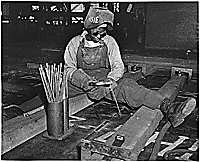
 |
During World War II, the Kaiser Company built shipyard child care centers for working mothers. This important but neglected landmark social experiment in American history affected the lives of working mothers and their children, particularly the shipyard workers in Richmond, California and Portland, Oregon.To maintain a profit and meet war production deadlines, the Kaiser effort, funded through the United States Maritime Commission, established 24 hour children centers. Kaiser's two shipyard children centers in Portland, the nation's largest, served nearly 4000 children. However, in both the Richmond and Portland Kaiser centers African American parents felt uncomfortable leaving their children in the care of white teachers. According to historian Shirley Ann Wilson Moore, "Many black women recalled that company child care services were 'available to the whites' only." Although the Kaiser Child Services Centers were atypical models they, nonetheless, are an exemplary demonstration of quality child care, unmatched to this day. At the close of the war, these Kaiser centers, along with 3100 other federal and state funded centers serving from 600,000 to 1.6 million children, were dismantled. California is the only state where publicly funded centers continued after the war.
Presently, 61 million American women hold jobs, the largest number of working women in our history, and the number continues to grow. Yet, the United States is one of only a few industrialized nations in the world without a high quality, comprehensive government supported system of child care. The current call for comprehensive child care which includes sick care, 24 hour care, drop-off care, emergency and low cost care is in reality a throwback. Solutions to the problem of what to do with children when parents work are not new. Sixty years ago this was not a problem because it was subsidized by federal and state agencies.
Chapter 2: Rosie the Riveter /W.W.II Home Front Park
The last few years has seen a growing recognition of women who worked
in W.W.II defense plants. These women worked as welders and laborers to
build ships and aircraft, from the East Coast to the South to the Pacific
Northwest. Although Rosie
the Riveter was a fictional character she depicted the many thousands
of women working stateside to win the war. These women are "our fore mothers
in the trade union movement, " said Donna Graves, a consultant to the Rosie
Project in Richmond, California.
Other Resources:
http://homepage.altavista.com/americanrosies/headquarters.html
http://www.sfgate.com/cgi-bin/article.cgi?file=/chronicle/archive/2000/07/27/MN102751.DTL
http://www.nara.gov/exhall/powers/women.html
Chapter 3: Collecting Names of Rosies and her Children for Amina's Ph.D. dissertation
Kaiser Shipyard Worker's Name (at time of work)__________________________________
Contact's Name _________________________
Address______________________________ City/State/Zip_______________________
Telephone_____________________________
At What Shipyard did you work?________________________________________________
What years did you work?_____________________________________________________
How long did you work at the shipyard?___________________________________________
Did you live in Public Housing units? Yes___
No___
Comments: What kind of work did you do at the shipyards?_____________________________
__________________________________________________________________________
__________________________________________________________________________
Do you have photos, letters, kept a diary?__________________________________________
__________________________________________________________________________